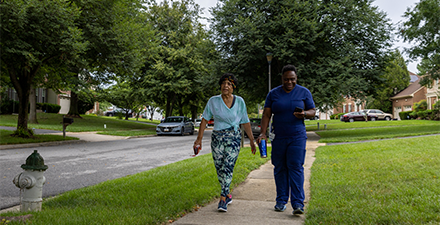When it comes to the "Choose to Move" theme of National Physical Therapy Month, PTJ: Physical Therapy & Rehabilitation Journal, APTA’s scientific journal, has been on board for years.
In recognition of NPTM, here are five studies published in PTJ that are definitely worth checking out. Most have to do with physical activity and adults who are older; three of the five are from outside the U.S. Combined, they point to the idea that, as asserted in the first article on this list, physical activity is indeed a public good that PTs and PTAs are uniquely positioned to promote. All APTA members enjoy unlimited access to PTJ.
1. Exercise should be more than medicine.
Article: Beyond "Exercise as Medicine" in Physical Therapy: Toward the Promotion of Exercise as a Public Good
"Exercise is medicine" is a familiar slogan. But is there a downside to conceptualizing physical activity as something to be prescribed? Authors of this article think so, exploring how the "exercise is medicine" concept introduces exclusivity while being a fundamentally reactive approach. Their recommendation: Physical activity must be recast as "more than medicine; it is a public good to be nurtured by physical therapists, their credentialing and licensure organizations, and their membership societies."
2. Sedentary behavior? Accept substitutes.
Article: Isotemporal Substitution of Sedentary Behavior With Moderate to Vigorous Physical Activity Is Associated With Lower Risk of Disability: A Prospective Longitudinal Cohort Study
This study from Japan looks at how gradually substituting physical activity for sedentary behavior over 14 days affected risk of disability among 3,691 community-dwelling adults 65 and older. The article points to some positive outcomes — but only when sedentary time was replaced with 10 minutes per day of moderate- to vigorous-intensity physical activity. Replacing with light-intensity PA didn't produce notable risk reductions, authors write.
3. It's game on for improving walking in older adults.
Article: Effectiveness of Exergame Intervention on Walking in Older Adults: A Systematic Review and Meta-Analysis of Randomized Controlled Trial Exergaming — what authors of this study describe as "serious games" — are computer-based games that are aimed at rehab, not necessarily recreation. They get attention in the media from time to time, but do they work? This systematic review analyzes 66 studies focused on the use of exergaming with adults 60 and older with neurological disorders, and finds that "exergaming has an effect equivalent to other types of exercising on improving walking in older adults."
4. Assumptions can play a big role in physical activity in retirement.
Article: The Meaning of Sedentary Behavior as Experienced by People in the Transition From Working Life to Retirement: An Empirical Phenomenological Study
This study from Sweden, which authors say is "grounded in a phenomenological life-world perspective," is based on interviews of 14 individuals aged 64 to 75 years aimed at uncovering attitudes and assumptions about sedentary time as people move into retirement. Interviewees were asked what it means to them to be sedentary, if they perceive themselves as sedentary, and "If you look into the future of your retirement, what are your thoughts related to activities and sedentary behavior in everyday life?" Many of the questions included follow-ups that probed more deeply into respondents' thoughts and feelings. The results help to paint a more complete picture of the ways attitudes shape behavior — and how those attitudes might themselves be shaped.
5. Dancing around the issue of falls risk may be a good idea.
Article: Effect of Senior Dance (DanSE) on Fall Risk Factors in Older Adults: A Randomized Controlled Trial
Shall we dance? Authors of this study from Brazil say strike up the band. Researchers recruited 82 community-dwelling adults 60 and older with no cognitive impairments to participate in a study in which half of the participants attended a twice-weekly group dance class for 12 weeks (the control group participated in an education program about falls prevention). They found that by the end of the program, the dance group was performing significantly better than the control group in the single-leg stance with eyes closed test, standing balance tests, sit-to-stand test, and 4-Meter walk tests. No differences were noted in cognitive function between the two groups.
